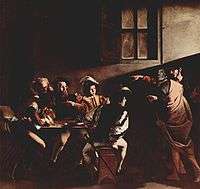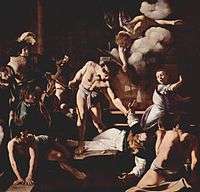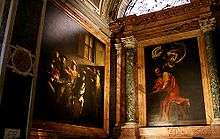Contarelli Chapel

The Contarelli Chapel is located within the church of San Luigi dei Francesi in Rome. It is famous for housing three paintings on the theme of Saint Matthew the Evangelist by the Baroque master Caravaggio. The chapel commemorates the French cardinal Matthieu Cointerel.
Chapel history
On his death in 1585 the French cardinal, Matthieu Cointerel (Contarelli in Italian), left an endowment and instructions for the decoration of the chapel, first one to the left of the apse, which he had purchased within San Luigi dei Francesi ("Saint Louis of the French"), the church of the French community in Rome in 1565.[1] The cardinal was rich—he had already paid for part of the construction of the church facade and put a large sum towards the high altar—and he specified that his chapel be decorated with scenes from the life of his name-saint, Matthew the Evangelist.
Artworks
Cointerel's executor, Virglio Cresenzi, commissioned a Flemish sculptor, Jacques Cobaert, to make a marble statue of Matthew and an angel for the altar. Giuseppe Cesari, one of the foremost artists then active in Rome, was contracted to fresco the two side walls and the vault. The details were clearly set out in the contract—Cobaert's altarpiece would show Matthew sitting in a chair, about to write the Gospel, with an angel standing and "appearing to reason or in other suitable pose." Cesari's side walls would show, on the right, Saint Matthew in his counting house (Matthew was a tax collector before becoming an apostle of Christ), suitably dressed, rising "to go to Our Lord, who, passing by with his disciples in the street, calls him..." On the left, Matthew at the moment of his martyrdom, celebrating Mass at the altar, with "a crowd of men and women, young and old and children...some appalled and others pitying..."

Cesari finished the vault by 1593, but then his attention and time were taken by Papal commissions. Cobaert produced nothing. In 1597 the money for the project was transferred to the Fabbrica di San Pietro, which administered the Church's buildings, yet still nothing happened. In 1599 preparations began for a Jubilee. "France...is not yet suffiently cleansed from the thorns and weeds of heresy and corruption," the Pope had told his French bishops. The new French king, Henry IV, had recently converted from Protestantism to Catholicism, but much remained to be done. Conversion, no less than martyrdom, was to be the Pope's theme with regard to France, Rome would be crowded with French pilgrims, and the chapel threatened to be boarded up. The clergy in charge of San Luigi became alarmed. The prefect in charge of the Fabricca, and of the money, Cardinal Francesco Maria Del Monte, suggested that his own personal painter, Michelangelo Merisi, known from his home town as Caravaggio, should be contracted to paint oils on canvas for the two side walls where Cesari would obviously never put his murals.
The contracts with Caravaggio were signed on 23 July 1599. Despite agonisings over the composition of the second painting, Caravaggio's The Calling of Saint Matthew and The Martyrdom of Saint Matthew were installed by July 1600. This was later than the contract called for (May 1600), but after more than two decades it must have been a relief to have anything at all. Moreover, the two paintings caused a sensation, and became the talk of Rome with their dramatic yet realistic approach to the familiar story from the Gospels. When Cobaert finally delivered his statues, the churchmen decided they didn't like them, and commissioned Caravaggio to do another painting for the altarpiece, still following the Cardinal's original instructions. The third and final work, The Inspiration of Saint Matthew, was in place by 1602—although not without difficulty, the first version was rejected for the vulgarity of the saint's crossed legs and bare feet, and for the overly-familiar way in which the angel cuddled up to him. In the second version on view today the angel keeps a respectful distance, and the saint is a little more dignified.

Caravaggio's solution to decorating a typically gloomy Roman church interior was revolutionary and brilliant. Visitors to the Contarelli Chapel today are confronted with paintings that use the gloom instead of fighting against it. The paintings themselves are dark - mostly shadow - one can surmise that perhaps the opportunity to use large amounts of shadow freed the artist to meet his pressing deadline - but certainly there has been a gain in drama, as the highlighted figures of saints and executioners leap out of the enveloping dark. Caravaggio also considered the lighting in the chapel: each of the two side paintings is lit by a beam of light coming from the same direction as the natural lighting in the chapel itself.
The decorative cycle began with the painting on the left side of the chapel, invisible to the viewer when first entering the church. It is a large panel of the Calling of St. Matthew, one of Caravaggio's most well-known works. On the right of the composition, Jesus and St. Peter look directly at a seated Matthew. Garbed in robes of antiquity, Jesus and his companion fit perfectly into the scene. Jesus points at Matthew, producing the Calling aspect. His hand is a direct reference to the receiving hand of Adam in the Creation of Adam panel on the ceiling of the Sistine Chapel. Matthew and his companions, in contrast, are wearing robes concurrent with Caravaggio's time. Matthew points at himself in a "Who, me?" gesture with one hand, while his other fingers coins on the table, referencing his previous vocation as a tax collector. (It has recently been suggested that the young boy with his head down at the end of the table is actually Matthew, and the older, bearded man traditionally identified as Matthew is pointing at this figure instead. The theory remains controversial). Another controversy surrounds the position of the large hand across the waist of the young man at the end of the table. The hand is clearly not his, but resembles the hand of the elderly man in furs who stands to the young man's left. Caravaggio was a notorious trickster with a well known penchant for young men, and it is entirely possible that this groping hand was intentional. There are many other examples of this playfulness, for example the Card Sharps where a young man conceals cards behind his back as his accomplice signals the card his opponent is holding.

On the right side of the wall, visible upon entry, is the Martyrdom of St. Matthew, depicting the scene in which Matthew meets his ultimate end. In contrast to the relatively staid Calling on the opposing wall, this scene has much action, swirling around the composition of hands at the center. Matthew at once wards off his attacker while reaching for the martyr's palm being dangled just out of his reach by the angel (It is also proposed that the main nude figure is not in fact the assassin but is instead a shocked catechumen. The bloodied sword in his hand is a retrieved weapon possibly dropped by the 'self portrait' of Caravaggio in the background who is actually the assassin. This figure appears to have been reaching for his weapon but is retreating with his fellow soldiers. This notion is not mainstream and is debatable.) Interesting components in this work include the nudes in the foreground who watch the scene unobtrusively, almost as if this is a theatrical production and the self-portrait of Caravaggio in the background (the bearded man).
 | |
|
| |
|
|
At the center of the chapel is The Inspiration of Saint Matthew, a scene in which an angel dictates to St. Matthew the gospel. Though not as intrinsically interesting as the other two, it provides an interesting interaction with the viewer's space. St. Matthew, jumping up to greet the angel, pushes his stool out over an apparent threshold created by the artist and into the realm of the viewer, this completes the interactive nature of this chapel, resulting in an intra-personal dialogue.
Although the three paintings by Caravaggio are today the star attraction of the chapel, the frescos by Cesari, who, although overshadowed by Caravaggio, nevertheless represent the final flowering of the Mannerist school. The Cesari fresco was finished about 1593, at which point Caravaggio was working for Cesari - who was only two years older. Cesari, an acute businessman as well as a skilful artist, valued his assistant's gift for painting flowers and fruit, and Caravaggio may have had a hand in the swags of greenery decorating the vault.
References
- ↑ Hess, Jacob (1951). "The Chronology of the Contarelli Chapel". The Burlington Magazine. 93 (579): 186–201. JSTOR 870607.
- ↑ "Caravaggio's paintings in the Contarelli Chapel, San Luigi dei Francesi". Smarthistory at Khan Academy. Retrieved December 20, 2012.
- ↑ "Caravaggio's Calling of Saint Matthew". Smarthistory at Khan Academy. Retrieved December 20, 2012.
Sources
- John Gash, Caravaggio, 2003 [ISBN 1-904449-22-0]
- Helen Langdon, Caravaggio: A Life, 1998 [ISBN 0-374-11894-9]
- Peter Robb, M, 1998 [ISBN 1-876631-79-1]
External links
| Wikimedia Commons has media related to Contarelli Chapel, San Luigi dei Francesi, Rome. |
Coordinates: 41°53′58″N 12°28′29″E / 41.89944°N 12.47472°E